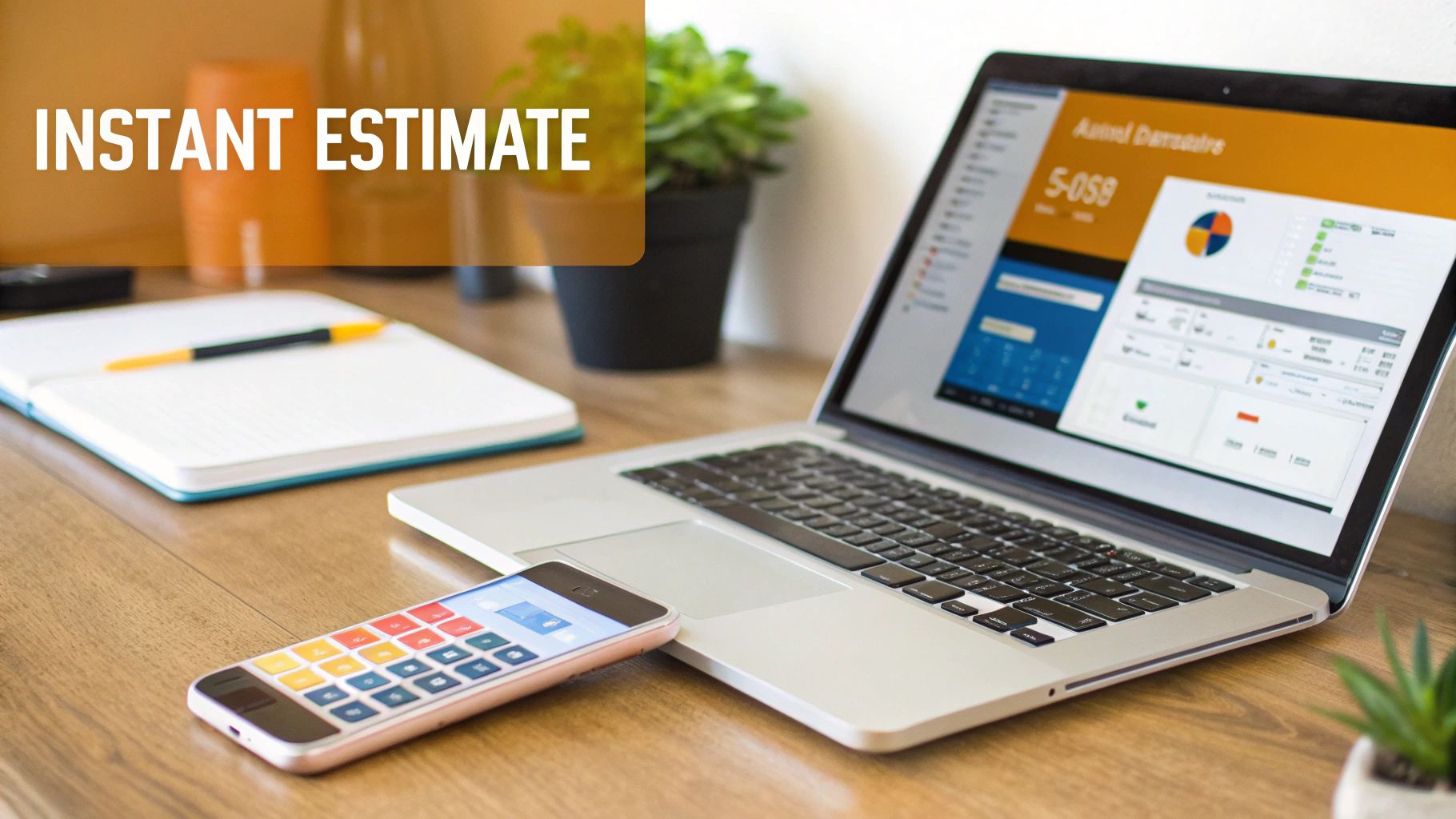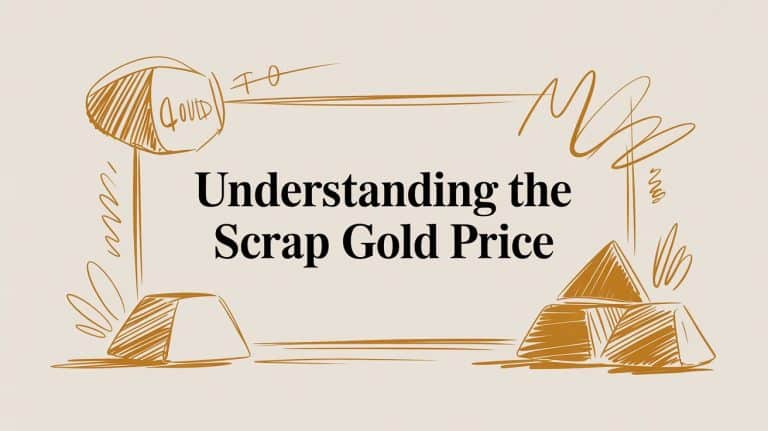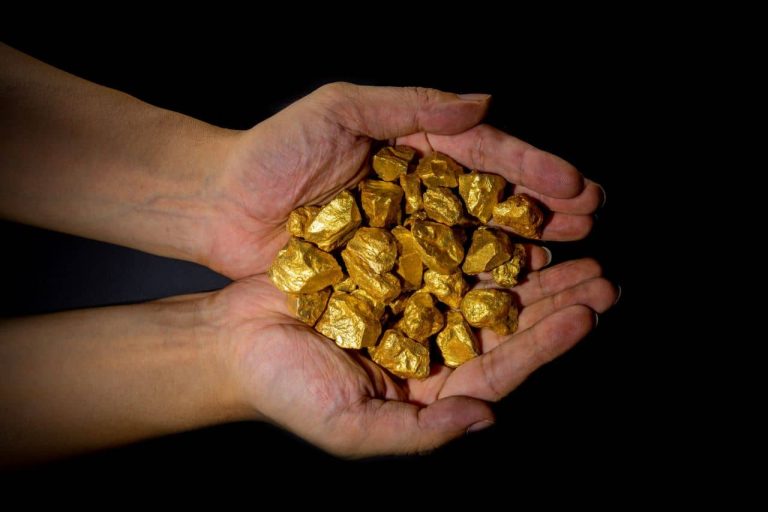Using a 10k Gold Calculator to Find True Value
A 10k gold calculator is a powerful tool designed to give you the melt value of your jewelry in seconds. It works by multiplying your item’s weight by its gold purity, which for 10k gold is 41.7% pure gold, and the current market price of gold. This straightforward calculation cuts through the guesswork, giving you a clear baseline number before you decide to sell.
What Is 10k Gold, Really?
Before you can figure out what your gold is worth, it helps to understand what you are actually holding. That “10k” stamp on your jewelry is not just a random marking; it is a precise measure of how much pure gold is in your item, which directly impacts its value.
Think of it like this: pure 24k gold is the main ingredient, but on its own, it is far too soft for jewelry that you would wear every day. To make it strong enough to handle daily life, jewelers mix pure gold with other metals like copper, silver, or zinc. This blend is called an alloy.
For a piece to be stamped 10k, it must contain 41.7% pure gold. The other 58.3% is made up of those stronger alloy metals. This specific recipe is what makes 10k gold a fantastic combination of affordability and durability, which is why you see it so often in rings, chains, and bracelets.
The Direct Link Between Purity and Price
The value of your 10k gold is tied directly to how much pure gold is actually in it. When a gold calculator gives you a price, it is not valuing the entire piece of jewelry. It is calculating the worth of just that 41.7% pure gold based on today’s market rates.
This is why understanding the composition is so important for setting realistic expectations. The math is simple: the value of 10k gold is the current price of pure gold multiplied by 0.417. You can find more insights on the current market values for 10k gold from expert sources.
The melt value of 10k gold is based only on its gold content. The other metals add strength and durability, but they do not contribute to the cash offer you will get from a gold buyer.
How 10k Gold Compares to Other Karats
To really get a feel for 10k gold, it helps to see how it compares to other common purities. Each level strikes a different balance between purity, durability, and that classic golden color. Knowing these differences helps you understand where your jewelry fits in the market.
| Karat Value | Pure Gold Content | Common Markings | Key Characteristic |
|---|---|---|---|
| 10k Gold | 41.7% | 417, 10k | Most durable and affordable option |
| 14k Gold | 58.3% | 583, 14k | A popular balance of durability and value |
| 18k Gold | 75.0% | 750, 18k | Richer yellow color with high value |
| 24k Gold | 99.9% | 999, 24k | The purest form, but too soft for most jewelry |
Having this foundational knowledge is the first step toward getting a fair deal. Once you understand that you are selling the gold within your jewelry, you can use a 10k gold calculator with confidence and know exactly what the numbers mean.
How to Manually Calculate Your 10k Gold Value
While an online calculator provides instant answers, understanding how to run the numbers yourself is empowering. It enables you to verify any offer you receive and gives you a serious edge when it comes time to negotiate. Crunching the numbers is surprisingly simple once you know the formula.
At its core, the calculation depends on just three things: how much your item weighs, its purity, and the current market price of gold, often called the spot price. Get these three right, and you will have a solid valuation.
This process shows that a finished piece of jewelry’s value comes right back to the amount of pure gold inside and its total weight, which are the exact inputs we need for our formula.
The Essential Tools for Valuation
Before you can start calculating, you need to gather some accurate data. Here is what you will need:
- A Digital Scale: Precision is everything here. A simple kitchen or postage scale that measures in grams will do the trick. Guessing the weight is the fastest way to get an inaccurate number.
- The Live Gold Spot Price: Gold prices are always on the move, changing throughout the day. You will need a reliable source for the real time 10k gold price per gram. Financial news sites or precious metal exchanges are your best bet.
- A Basic Calculator: Your smartphone’s calculator app is all you need to tie it all together.
With these ready to go, you can jump into the actual math.
The Core Valuation Formula
Figuring out the melt value of your 10k gold is just a simple multiplication problem. You can dive deeper into the specifics of the gold calculation formula on our site, but the basic structure is universal.
The formula looks like this:
Weight × Purity Multiplier × Spot Price = Melt Value
Let’s break that down. The purity multiplier for 10k gold is always 0.417, which reflects its 41.7% pure gold content. For instance, if you have a 10k gold item weighing one troy ounce and the spot price is $1,400 per ounce, its melt value would be around $583.80 before any refining fees are deducted (1 oz × 0.417 × $1400).
To see this in action, check out the table below. We have run a few examples using a hypothetical gold spot price of $70 per gram.
10k Gold Melt Value Calculation Examples
This table shows a few hypothetical calculations for different weights of 10k gold, all based on the same sample gold spot price. This really highlights how the weight of your item directly scales its final melt value.
| Item Weight (grams) | Gold Spot Price (per gram) | 10k Purity Multiplier | Calculated Melt Value |
|---|---|---|---|
| 5.0 grams | $70.00 | 0.417 | $145.95 |
| 12.5 grams | $70.00 | 0.417 | $364.88 |
| 20.0 grams | $70.00 | 0.417 | $583.80 |
As you can see, once you have the weight and the current spot price, getting that baseline value is just simple multiplication. This calculated melt value becomes your starting point for any conversation with a potential buyer.
Using an Online 10k Gold Calculator The Smart Way
Doing the math yourself is great for understanding the fundamentals, but let’s be honest, online tools are just faster and easier. A good digital 10k gold calculator gives you instant, real time results without the hassle. These tools are wired directly into live market data, so you do not have to go hunting for the current spot price.
The best part is their simplicity. You just need to plug in a few details about your gold, and the calculator does all the heavy lifting in a matter of seconds.

Plugging in the Right Numbers
To get a number you can trust, you have to feed the calculator the right information. Any decent scrap gold calculator will ask for these key details:
- Weight: This is the total weight of your 10k gold. You absolutely need a precise digital scale for this; eyeballing it or using a kitchen scale just will not cut it.
- Unit of Measurement: You will usually see options for grams, pennyweight (dwt), and troy ounces. For jewelry, grams are the industry standard and the easiest to work with.
- Karat (Purity): This is where you will select 10k from the dropdown menu. This tells the calculator to use the 41.7% purity multiplier for its math.
- Currency: Pick your local currency (USD, EUR, GBP, etc.) to see the value in terms you actually use.
Once you have entered everything, the calculator instantly multiplies your item’s pure gold content by the live spot price to give you its melt value.
What the Results Actually Mean
The number that pops up on the screen is the melt value. It is critical to understand what this figure represents. The melt value is the raw, theoretical worth of the pure gold in your item based on today’s market; it is not the check you will walk away with.
A gold buyer’s offer will almost always be lower than the melt value. This is not a scam; it is just business. They have costs to cover like refining, assaying, insurance, and of course, their own profit margin.
Think of the melt value as your baseline. It is the 100% figure that every offer will be based on. Knowing this number before you even talk to a buyer is your best defense against a lowball offer and helps you spot a fair deal when you see one.
How Different Inputs Change Your Payout
To see this in action, look at how tweaking the weight or karat affects the final value. This table assumes a constant gold price of $70 per gram to make the comparison clear.
| Weight (grams) | Karat (Purity) | Gold Content (grams) | Calculated Melt Value |
|---|---|---|---|
| 10 grams | 10k (41.7%) | 4.17 g | $291.90 |
| 10 grams | 14k (58.3%) | 5.83 g | $408.10 |
| 15 grams | 10k (41.7%) | 6.26 g | $438.20 |
As you can see, both weight and purity directly impact the final number. Using an online 10k gold calculator is the smartest first step you can take. It arms you with the knowledge you need to walk into any negotiation with total clarity and confidence.
Understanding the Payout From a Gold Buyer
So you have punched the numbers into a 10k gold calculator, you have your melt value, and you walk in feeling prepared. But then the offer comes in, and it is almost always lower than the figure on your screen. This is not a red flag or a sign of a bad deal; it is just how the gold buying business works.
The number a calculator gives you is the 100% melt value, the raw, theoretical worth of the pure gold locked inside your item. A gold buyer, however, has to run a business. Just like a retail store buys products at wholesale and sells them at a higher price, a gold buyer’s offer has to account for their costs and leave room for a profit.
Why Offers Are Less Than Melt Value
A buyer cannot offer you the full spot price for your gold because they have several legitimate business costs to cover. These expenses are part of the process, whether you are at a local jeweler, a pawn shop, or an online refinery.
Here’s a breakdown of what is going on behind the scenes:
- Refining and Assaying Costs: Your 10k jewelry is not pure gold. It has to be melted down to separate the 41.7% gold from the other alloy metals. This industrial process, called refining and assaying, is not free.
- Operational Overhead: Rent, employee salaries, insurance, high level security, these are all real costs of running a business that handles precious metals.
- Market Volatility: Gold prices can swing wildly, sometimes in a matter of minutes. The buyer takes on the risk that the spot price could drop between the moment they buy your gold and when they can sell the refined product.
- Profit Margin: At the end of the day, a gold buyer needs to make a profit to stay in business. That margin is the reason they provide the service of turning your unwanted scrap into cash.
When you add all these factors up, a realistic cash offer for scrap gold typically lands somewhere between 70% to 90% of the melt value you calculated.
A quick tip from experience: The more gold you are selling, the better the percentage you are likely to get. Fixed costs like refining are easier to absorb on a larger batch, so buyers can often afford to offer a more competitive rate for bigger hauls.
Setting Realistic Payout Expectations
Knowing this industry standard helps you spot a fair deal. If an offer comes in below 70%, it is probably a lowball. On the other hand, anything pushing 90% is an excellent payout for a typical seller.
To put it into perspective, let’s look at how the numbers play out.
Melt Value vs. Typical Payout Percentage
This table shows what you might actually pocket based on a few different melt value calculations. It is a great way to manage your expectations before you even start negotiating.
| Calculated Melt Value | Typical Payout (75%) | Excellent Payout (85%) |
|---|---|---|
| $200.00 | $150.00 | $170.00 |
| $500.00 | $375.00 | $425.00 |
| $1,000.00 | $750.00 | $850.00 |
Understanding this gap between the calculated value and a real world cash offer is the most important step. It moves you from just having a number to being an informed seller who can confidently assess offers and walk away with a fair price.
Actionable Tips for Selling Your 10k Gold

Knowing your gold’s melt value is a great starting point, but it is just that, a start. Getting the best possible price for your 10k gold requires a bit more strategy than simply walking into the first shop you see.
One of the biggest mistakes people make is accepting the first offer they get. With a few insider tips, you can navigate the selling process with confidence and walk away with more cash in your pocket.
The single most effective thing you can do is get multiple quotes. Never, ever sell to the first buyer you talk to, whether it is a local jewelry store, a pawn shop, or an online mail in service.
Each business operates with different overhead costs and profit margins, which means their offers for the exact same items can vary dramatically. By shopping your gold around, you create competition and give yourself the leverage to negotiate a better deal. For a deeper dive, check out our guide on where to sell gold for the highest price.
Prepare Your Gold to Get a Better Offer
How you present your items can make a real difference. Preparing your gold before you approach a buyer not only makes the process smoother but can also lead to a more transparent and favorable valuation. It shows you are an informed seller who knows what they are doing.
A simple but effective step is to organize your jewelry by karat. If you have a mix of 10k, 14k, and 18k pieces, separating them beforehand is a smart move. This prevents a buyer from lumping everything together and valuing the entire lot based on the lowest purity item.
Gently clean your gold jewelry with a soft cloth before taking it in. While dirt and grime do not add weight, presenting clean, well organized items makes a professional impression and streamlines the appraisal process for the buyer.
Use Market Trends to Your Advantage
Timing can play a huge role in the price you get. Gold prices fluctuate daily based on global economic factors, so having a sense of the bigger picture can help you decide when to pull the trigger. You do not need to be a market analyst, but a quick check of recent trends provides valuable context.
For example, historical data shows that gold prices have seen substantial growth over the last decade. The price per gram has climbed significantly, moving from lows around $33 to recent highs of over $110. Since your 10k gold’s value is directly tied to these spot prices, understanding these trends can help you feel more confident about selling now or waiting for a different market cycle.
By comparing offers, organizing your items, and having a basic grasp of market trends, you transform from a passive seller into an empowered one. These strategies ensure you are not just accepting a price, you are actively securing the best one possible for your gold.
Common Questions About 10k Gold
Even with all the numbers crunched, it is totally normal to have a few questions lingering in your mind. When you are dealing with something as valuable as gold, you want absolute clarity. Let’s dig into some of the most common questions people ask after they have calculated their 10k gold’s value.
Getting these answers straight will give you the confidence you need to walk into a negotiation feeling prepared and in control.
Is 10k Gold Even Considered Real Gold?
Yes, absolutely. Any jewelry sold in the United States must have at least 10 karats of gold to be legally called “gold.” While it has a lower gold content than a 14k or 18k piece, its 41.7% pure gold content is very real and definitely has value.
That specific blend of gold and other metals is what makes it tough enough for everyday wear. But when it comes to selling, remember the value is based strictly on that 41.7%, not the item’s total weight.
Why Is My Offer So Much Lower Than the Calculator’s Value?
This is probably the most frequent question we hear, and it gets to the heart of how the gold business works. A 10k gold calculator shows you the melt value, the full, raw market price for the pure gold locked inside your jewelry.
A gold buyer, on the other hand, has to give you an offer that keeps their lights on. Their quote has to cover a bunch of real world costs:
- Refining Fees: The cost to physically melt down your items and separate the pure gold from the other metals in the alloy.
- Assaying Costs: Verifying the exact purity of the gold after it has been refined.
- Overhead: All the standard costs of doing business, rent, security, insurance, and paying their team.
- Profit Margin: The small percentage they need to earn to stay in business and offer the service.
When you factor all this in, a fair cash offer will almost always land somewhere between 70% to 90% of the melt value you calculated online.
Does a Gold Calculator Factor in the Gemstones?
No. A standard gold calculator is built to do one thing: tell you what the metal is worth. When you take your jewelry to a buyer, they will almost always remove any stones before weighing the gold. This is the only way for them to get an accurate measurement of just the precious metal.
If you have a piece with stones you believe are valuable, like diamonds, sapphires, or emeralds, it is smart to get them appraised by a qualified jeweler or gemologist before you sell the item for its scrap gold value.
How Often Should I Check the Live Gold Price?
The price of gold is always on the move whenever the global markets are open. For the most accurate calculation, you should check the live spot price right before you plan to sell or negotiate. Good online calculators and financial news sites refresh their gold price every few minutes, giving you a precise, up to the minute number to work with.
Ready to see what your gold is worth right now? The Gold Calculator is a free, simple tool that uses real time market data to give you an instant melt value for your items.








